Like a phoenix from the ashes, the death of the ARC Tunnel (Access to the Regions Core) has lead to a new idea which has ignited people’s imaginations: extending the 7 Line to Secaucus, NJ.
A bit of backstory for the uninitiated: The ARC Tunnel has been in the works for a good two decades. As more and more commuters flow in and out of Manhattan from New Jersey every year, the century old Penn Central tunnels from Secaucus into Manhattan began to reach their maximum capacity. To alleviate this, planners have been working on building a new set of tunnels under the Hudson River, which would allow trains that would normally need to terminate in Hoboken to reach Manhattan. Much noise had been made about the final plan, which would have sent trains through Secaucus Junction station twice and dug a massive new train terminal under Macy’s department store (meaning that the new tunnels would not at any point feed into the existing Penn Station). The price tag was initially set at $8.7 billion and construction, what had started, was to last for 8 years. Most people distrusted these numbers.
When Gov Chris Christie was elected in 2009 one of the first things he took aim at was New Jersey’s bloated, unbalanced budget. Knowing that the state could not afford the projected cost overruns, Christie killed the project in October 2010. In doing so, he sent back $3 billion of Federal funds to Washington which had been allocated for the project.
Days later, an idea popped its head out from the rubble, an idea which at any other time would have never been taken seriously: extend the 7 Line to Secaucus instead. In my futureNYCSubway post about cross-Hudson subways I mentioned that besides the engineering challenges of tunneling under the Hudson River were political ones. The Metropolitan Transportation Authority runs the New York City Subway (among other things) but their jurisdiction ends at the border. The Port Authority of New York and New Jersey has authority over all bridges and tunnels which cross the border in the New York-New Jersey area. Because of this, the prospect of extending the NYC Subway into another jurisdiction would add so many more levels of bureaucracy that most planners wouldn’t even consider proposing the idea. But in strange times like this when a project which was all but certain is dead and gone, people begin to think outside the box.
What makes the idea of extending the 7 Line into New Jersey interesting is that the 7 Line extension from Times Sq to the Jacob Javits Center is already well under construction and paid for. The equipment is already there, working day and night, and could theoretically just keep digging. But where, exactly, would the new line go? The proposal is so new that no maps, other than a rough sketch, have been made. Even my plan to extend the 7 Line into New Jersey had the line run through Hoboken and Jersey City instead of Secaucus.
Digging to Secaucus makes more sense than going to Jersey City. Secaucus is already a giant transfer station for trains that don’t go into Manhattan. Terminating the subway there would allow for commuters to connect to other subway lines and to Grand Central Terminal, something the original ARC plan would have not reached (though there were ideas to connect the new tunnel to the also-under construction East Side Access through Grand Central). The plan, at least as I’ve imagined it, would continue the 7 Line from W 25th St (where the current tunnels under construction stop) under the Hudson River to a point under 9th St in Hoboken, NJ with a station at Washington Ave. The tunnel continues west under 9th St with a station at the Hudson-Bergen Light Rail station at 9th St. The tunnel dives into the hard rock of the Palisades and turns north under Washington Park up to Secaucus Rd with a station serving Summit Ave. Following Secaucus Rd, the line comes to the surface via a new portal near Tonnelle Ave, past which a new park-and-ride facility will be built. From here the line runs along an embankment to the Secaucus Junction station.
Leaving the extension here would still be immensely helpful for commuters. But what no one has mentioned yet is that from Secaucus it would be a straight shot to Newark-Liberty Airport. The 7 Line already serves LaGuardia Airport via a shuttle bus and planners have, for years, imagined ways to connect the 3 major airports in the region via mass transit. The 7 Line would whisk travelers from the airport to Times Sq, Midtown, Grand Central, and would connect to most of the other subway lines; The plan is so simple and perfect. A traveler needing to switch from JFK to Newark-Liberty could take the Queens Blvd express E train to Times Sq and change to the 7 to Newark-Liberty without having to pay for a second train at Penn Station (as one would have to do presently). On my map I have additional stations at Harrison, Newark Penn Station, and Ironsides. A direct line into Midtown Manhattan would do wonders for the economy of the city of Newark.
A major incentive to building the 7 Line extension to Secaucus is that it would cost half that of the ARC tunnel, since most of the major infrastructure in Manhattan is already built. No real numbers have been studied yet, and the route planned here is just as much hearsay as any other. But the potential of congestion relief and economic growth for both New York and New Jersey have captured the imaginations of both states. The unfortunate reality, though, is that because New Jersey gave its money back to the Federal government, any new project will take many years of review to actually get off the ground. While the tunnel-boring machines are still turning in Manhattan, they won’t magically keep going under the Hudson.

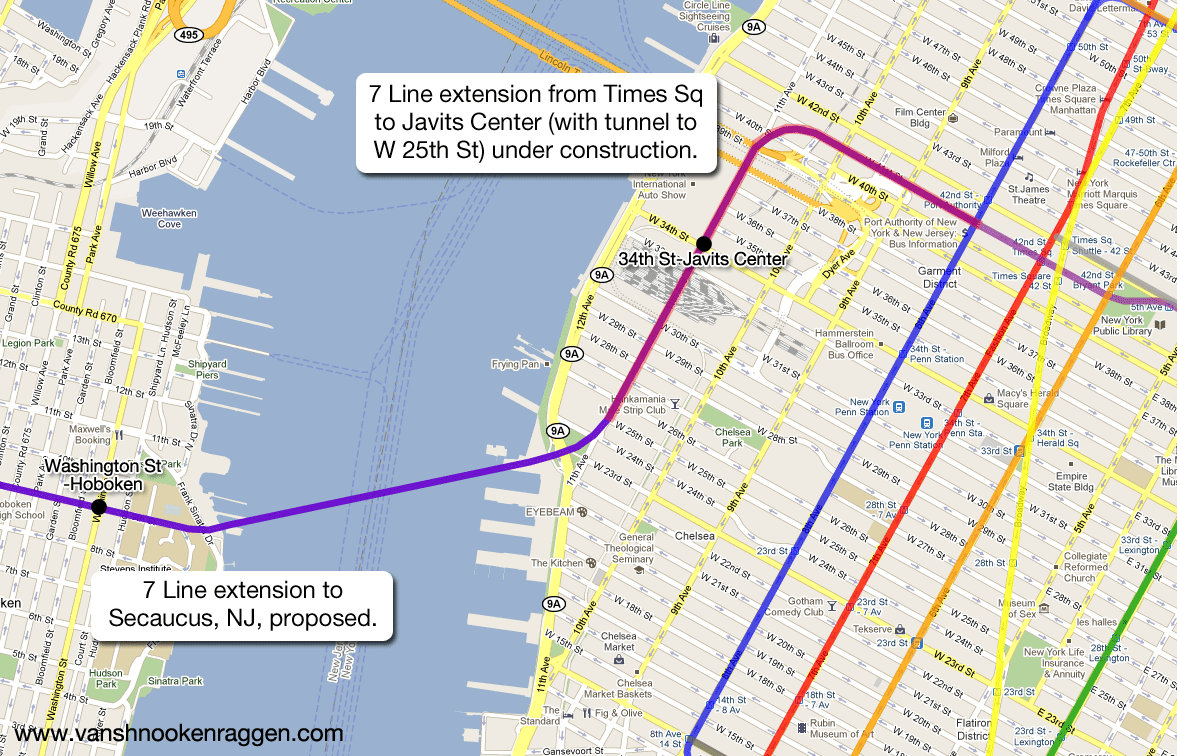
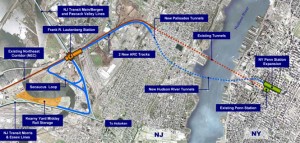
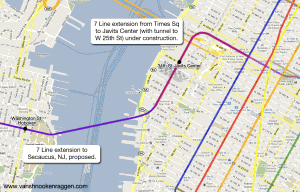

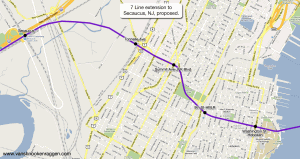
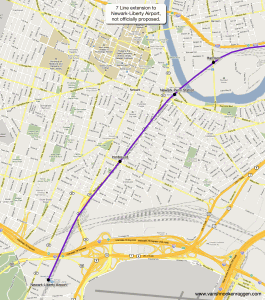
Well done
Why not run the seven train down 11th avenue towards 14th street, and then cut diagonally to the Hoboken terminal, connecting the 7 train to all the lines of NJ transit directly, the PATH train, and the hudson bergen light rail? Doing so would solve several problems, and be more cost effective. The Secaucus option would have to travel a considerable larger distance and would not connect to the PATH or hudson bergen rail lines, let alone the fact that Secaucus Junction is isolated from the town of Secaucus or other residential development. Compare this to Hoboken, which is in the middle of a growing city, and includes links to Jersey City, Weehawken, West New York, etc. Speaking to cost, extending the terminal into the water on landfill, the cost to tunnel from hoboken to 14th street would be considerably less than the distances from 23rd street to secaucus. Lastly, by tunneling from 14th street, perhaps there could also be a connection to an extended L train, which would allow direct connections to the ACE (instead of walking an avenue under times square from the 7, and provide quicker access to points south of 14th street instead of crowding the midtown routes. One last thing, a L/7 connection to Hoboken would allow through trains to proceed directly to the Newark Airport NJ transit stop, providing a one seat ride from grand central/times square to the Newark Air tran. The current mass transit system has travellers having to transfer to NJ transit at either Penn Station or Hoboken, and having to pay for a subway/path ride in addition to the nj transit to Newark Airport. I know Secaucus is a fancy new station with transfer points to the NJ transit lines, but it seems that Hoboken would be a better choice, for the reasons stated above. Cost, which is king these days, seems to greatly favor the Hoboken option. How come nobody has mentoined this before?
In response to Matthew:
While tunneling the 7 to Hoboken is a novel idea and likely to cost less than tunneling to Secaucus, the problem lies in the fact that a limited number of trains can travel to Hoboken on NJ Transit lines. Hoboken Terminal is already at capacity according to NJ Transit. There will not be enough capacity on NJ Transit’s Hoboken trains to handle all the people coming from the Northeast Corridor trains (NJ Transit’s busiest line) wanting to go to Grand Central, in addition to the riders from the other two lines (North Jersey Coast and Raritan Valley) that will now wish to travel to Hoboken instead of NYP. Operational capacity is also limited by the fact that there’s only one track (Waterfront Connection) that can be used for trains going in BOTH directions between Newark Penn and Hoboken, so they can’t just add more trains at will. Building another track connection will cost more $$$. For this reason, Secaucus is the better choice.
Also, in regards to running the NYC subway via Hoboken thru to EWR (Newark Airport) on existing NJT tracks, that is operationally infeasible since subway trains use third rail, and NJ Transit trains use overhead catenary. Besides, as stated above, there is NO AVAILABLE CAPACITY for more trains going through Hoboken. The only way for the direct connection to work is via a new dedicated right-of-way, which of course costs more $$$ and will not happen.
Howdy. Great site. have you played around with the NCYMate app for android/iphone? seeing as you’re a map buff, I thought i’d let you in on a little project i am in the middle of. so the NYCMate people managed to get copies of those awesome Neighborhood maps that you find at the subway stations from the MTA. i downloaded a packet sniffer app for my phone, and sniffed out the url where all of those neighborhood maps are individually downloaded from when you run their app. They are 65 in number broken into 35 pieces per map, and roughly 2400*3100 in dimension per map when the 35 pieces are stitched together. I wrote a little batch file script to take advantage of irfanView’s commandline capabilities, specifically ‘panorama’, where it can stitch together jpegs, thus reassembling each map. It’s a pretty awesome set of maps that i really wish the MTA would make public, and now i’ve got ’em. Shoot me an email, Van, if you want to see them. I am going to try to stitch all 65 big maps together in photoshop to form one massive NYC neighborhood map. It’s extremely detailed, including tons of venues, all bus routes, and street names and addresses. But I think that massive file might break the .jpg file size limit…
And it is picking up steam…again.
http://abclocal.go.com/wabc/story?section=news/local/new_jersey&id=8406903
FIRST… This plan opens a can of worms like you would not believe. It would take more than just ceding control to the Port Authority. It would take an act of Congress and in this Congress, NOTHING gets done. It would take an act of Congress because it would turn the subway system into an interstate RAILROAD subject to regulations — and work rules — promulgated by the Federal Railroad Administration. Is that what the MTA wants? I seriously doubt that.
SECOND… You are talking about the “Macy’s Plan” but what happened to the Moynihan Plan to terminate Jersey commuter traffic at the Farley Post Office?
My understanding was that the Macy’s Plan was just another pie-in-the-sky proposal by the idiots that run the Tri-State Regional Planning Commission and was neither approved nor funded. Was that crazy plan actually approved by Congress?
If the reason Gov. Christie vetoed construction was because he would be billed for tunneling to Macy’s he was absolutely correct in his judgment. The anticipated traffic could never be justified by the huge costs of underpinning five railroads (8th Ave., 7th Ave, PATH, LIRR 34th St yards, 11th Ave Amtrak) plus sewers, water and wire utilities.
I’ll give Christie some credit as New Jersey was going to be unfairly burdened buy the cost of the ARC Tunnel when New York should have carried some of the cost.
The truth about Moynihan Station is that no one really wanted it. By this I mean Amtrak, NJT, or the MTA didn’t want it because Farley Post Office is located very far away from the CBT of Midtown Manhattan. The point of the Macy’s Plan was that it got more people closer to where they wanted to be. The Moyniahn Station is a wonderful political proposal but until the Far West Side is actually built out it will be only that.
And I agree that the political challenges are just as steep, if not more so, than the physical challenges. If anything I would hope that this project would actually lay the ground work for an inter-state subway system. If the political challenges can be worked out here then that opens the doors for many more projects in the future like a subway to Staten Island through Bayone, NJ or finally building mass transit over the George Washington Bridge.